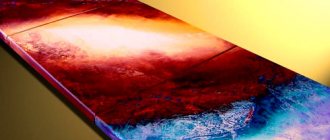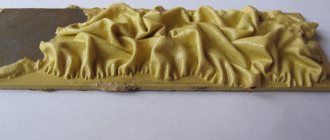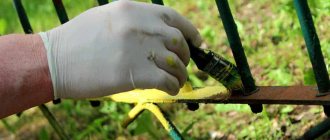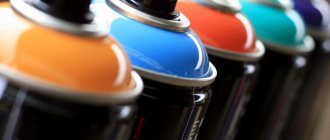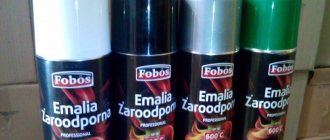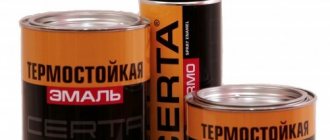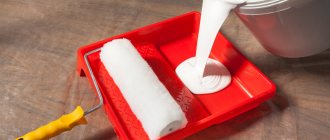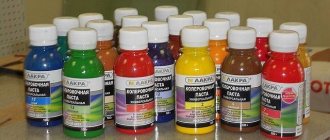Polyurethane paint for metal gets its name from the polymer on the basis of which it is made. It is used in various fields of industry and construction, as it has several unique properties. To understand where it is best to use this coloring composition and how to obtain a high-quality result, it is important to study the technical characteristics, properties, and principles of applying enamel.
Paint for metal (Photo: pixabay.com)
Characteristics
Specifications:
- adhesion of the resulting film - 2 points;
- hiding power - up to 75 g/m2;
- viscosity - up to 90 units;
- content of volatile substances from the total mass - 34%;
- approximate consumption - 150 g/m2;
- resistance to temperature changes - from – 40°C to +150°C.
On sale you can find enamels that, after drying, form a glossy or matte finish.
Painted car (Photo: pixabay.com)
Prices
The price of anti-gravel protection for a car body will depend on the class of the car.
You can find a table where car brands and models are described in detail from grades 1 to 6 on our website. The cost of the work includes consumables and materials, as well as preparatory work and payment for the work of the master. *Prices for services may change due to changes in exchange rates!
CLASSIFIER FOR POLYURETHANE FILM
| Brands | 1 class | 2 - class | 3 - class | 4th grade | 5 - class |
| ASTON MARTIN | Rapide, Vantage, DB, Lagona, Vanquish, Vulcan | ||||
| AUDI | A1, A2, | A4, A5, | A6, A7, Allroad, Q3, Q5, e-tron | Q8,Q7, A8,RS7,RS6, R8 | |
| BMW | 1, 2, | 3,4,X1,X2 | 5, 6, X3, X4 | X7, 7 long, 7, 8 x5 x6 | |
| BENTLEY | Mulsanne, Arnage, Continental GT, Flying Spur, Bentayga | ||||
| CADILLAC | CTS, ATS, BLS | SRX, STS | Escalade, Escalade ESV | ||
| CHEVROLET | Aveo, Lacetti, Spark | Captiva, Evica, Rezzo, Niva, Cruze | TrailBlazer, | Tahoe, Chevrolet Traverse, Suburban, Corvette | |
| CHRYSLER | Neon | Sebring, Stratus, PT Cruiser | 300C, Grand Voyager, Pacifica | ||
| CITROEN | C2, C3, C4 | C6, Picasso, Berlingo, C5, DS-5 | C-crosser | ||
| DODGE | Challenger, Charger | Durango, RAM | |||
| FERRARI | California, 458, F12, 812, FF, GTC4 | ||||
| FORD | Fusion, Focus, Fiesta, Ka | Mondeo, | Kuga, Maverick, Escape, S-Max | Explorer, Mustang Raptor, F-150 | |
| HONDA | Jazz, Civic | HR-V, Accord, Prelude | CR-V, Legend, Element, Crosstour | Ridgeline | |
| HUMMER | H3 | H2 | |||
| HYUNDAI | Getz, I30, Atos, Solaris | Sonata, Tucson, IX35, Matrix, Gran Deur | Santa Fe, IX55, Terracan, Genesis | Eques, H1, Starex | |
| INFINITI | Q30 | Q50 | QX70 | QX60, QX80 | |
| JAGUAR | XF, | XJ,F-pace,F type | |||
| JEEP | Wrangler, Liberty | Grand Cherokee | |||
| KIA | , Picanto | Ceed, Rio | Optima, Sportage, Venga, Soul | Mohave, Quoris, Sorento | |
| LAMBORGHINI | all models | ||||
| LAND ROVER | Freelander, Evoque | Discovery, Freelander, Evoque | Range Rover long, Range Rover vouge, Range Rover Sport | ||
| LEXUS | IS, CT | IS, CT | LS, GX,NX, ES, GS | LX,RX | |
| MASERATI | Ghibli, Levante | ||||
| MAZDA | 2, 3, MX-5 | 5, 6, CX-5 | MPV, CX-7,CX-5 | CX-9, BT-50 | |
| MERCEDES-BENZ | A class | C class, E class, CLA | ML, CLS, All AMG series sedans | GLE, GLS, GLE coupe, S-class, V class | G class |
| MINI | Cooper | Countryman, Clubman | |||
| MITSUBISHI | Colt, | Lancer | L-200, Outlander XL, Pajero, Pajero Sport | ||
| NISSAN | Note, Tiida, Micra | Teana, Almera, Tiida, | Murano, Teana, X-Trail, Juke, Qashqai | Navara, Pathfinder, Patrol, GTR | |
| OPEL | Astra, Corsa | Zafira, Insignia, Omega, Vectra, Meriva | |||
| PEUGEOT | 107, 207, 308 | 407, 508, Partner | |||
| PORSCHE | Macan, Cayman, Boxster, 911, | Cayenne, Panamera | |||
| RENAULT | Clio, Logan, Symbol | Kangoo, Duster, Fluence, Scenic, Megane, Laguna | Koleos | ||
| ROLLS-ROYCE | Cullinan, Phantom, Ghost, Wraith, Ghost, Wraith | ||||
| SKODA | Fabia, Rapid, | Octavia, Superb, Roomster, | Kodiaq, Karoq, Yeti | ||
| SUBARU | Legacy, Outback, Impreza XV | Tribeca, Forester, | |||
| TOYOTA | Auris, Yaris | Avensis, Prius, Versa, GT86, Camry, Corolla, Crown | Venza, Highlander, FJ Cruiser | LC200, Prado, Tundra, Sequoya, Alphard | |
| VOLVO | C30, S40 | CC, S60, V50, XC40 | XC60, XC70, V70 | XC90, S90, S80 | |
| VOLKSWAGEN | Polo,Beetle | Passat, Golf plus, Jetta, Scriocco, | Tiguan, Touran, Sharan, | Phaeton, Touareg, Multivan, Transporter | |
| TESLA | Model 3 | Model S, Model Y | Model X | ||
| TOYOTA | Auris, Corolla, Prius, Verso | Avensis, Camry up to 2016, GT | RAV-4, Venza, Camry after 2016 | Highlander, Alphard, LC 200, LC Prado, Hiace, Sequoia, Tundra | |
| VOLKSWAGEN | Beatle, Bora, Golf, Polo, Sirocco, Jetta | Caddy, CC, Passat, Touran | Tiguan | Amarok, California, Multivan, Toureg | |
| VOLVO | C30, C70, S40 | S60, S80, V40 | XC60, XC70, XC90 |
| GLOSSY POLYURETHANE | |||||||
| Class | full wrap work | polyurethane film cost per meter | meters of film | material | total glossy polyurethane | ||
| 1 | 90000 | 8000 | 16 | 128000 | 218000 | ||
| 2 | 100000 | 8000 | 18 | 144000 | 244000 | ||
| 3 | 120000 | 8000 | 20 | 160000 | 280000 | ||
| 4 | 140000 | 8000 | 22 | 176000 | 316000 | ||
| 5 | 175000 | 8000 | 24 | 192000 | 367000 | ||
| MATTE POLYURETHANE | |||||||
| Class | full wrap work | polyurethane film cost per meter | meters of film | material | total matte polyurethane | ||
| 1 | 90000 | 8000 | 16 | 128000 | 218000 | ||
| 2 | 100000 | 8000 | 18 | 144000 | 244000 | ||
| 3 | 120000 | 8000 | 20 | 160000 | 280000 | ||
| 4 | 140000 | 8000 | 22 | 176000 | 316000 | ||
| 5 | 175000 | 8000 | 24 | 192000 | 367000 | ||
Price list for polyurethane pasting kits
| detail | Job | film | sum |
| windshield pillars | 4000 | 1000 | 5000 |
| roof strip | 4000 | 2500 | 6500 |
| PTF (without removing the bumper) | 2000 | 500 | 2500 |
| zones under the handles 4pcs | 2500 | 500 | 3000 |
| unloading area | 2500 | 2000 | 4500 |
| Inter-window racks 6pcs | 6000 | 2000 | 8000 |
| interior thresholds | 6000 | 3500 | 9500 |
| tail lights | 5000 | 1000 | 6000 |
| door sill stickers | 2000 | 500 | 2500 |
| № | Body Protection Kits | Parts included in the set | Class 1-2 | grade 3-4 | Class 5 | |||||||||
| Job | film | total | Job | film | total | Job | film | total | ||||||
| 8000 | 8000 | 8000 | ||||||||||||
| 1 | Standard body protection kit | hood, bumper, lane fenders, headlights, mirrors | 35000 | 5,5 | 44000 | 79000 | 45000 | 5,5 | 44000 | 89000 | 55000 | 6 | 48000 | 103000 |
| 2 | Body protection set standard + | hood, bumper, lane fenders, headlights, mirrors, windshield pillars, roof strip, PTF | 45000 | 6 | 48000 | 93000 | 55000 | 6 | 48000 | 103000 | 65000 | 6,5 | 52000 | 117000 |
| 3 | Extended body protection set | hood, bumper, lane fenders, headlights, mirrors, windshield pillars, roof strip, PTF, areas under the handles, rear unloading area. Bumpers, window pillars | 55000 | 6,5 | 52000 | 107000 | 65000 | 6,5 | 52000 | 117000 | 75000 | 7 | 56000 | 131000 |
| 4 | Maximum body protection set | hood, bumper, lane fenders, headlights, mirrors, windshield pillars, roof strip, PTF, areas under the handles, rear unloading area. bumpers, inter-window struts, interior sills, rear optics, front part of the sills | 65000 | 7 | 56000 | 121000 | 75000 | 7 | 56000 | 131000 | 85000 | 8 | 64000 | 149000 |
| Class | 1 and 2 | 3 , 4, 5 | ||
| detail | Job | material | Job | material |
| hood | 7500 | 16000 | 8500 | 16000 |
| 23500 | 24500 | |||
| bumper | 12500 | 13000 | 15000 | 13000 |
| 25500 | 28000 | |||
| rear fender | 10000 | 32000 | 10000 | 36000 |
| 42000 | 46000 | |||
| front wing | 4000 | 8000 | 4000 | 8000 |
| 12000 | 12000 | |||
| headlights pair | 3500 | 1500 | 5000 | 1500 |
| 5000 | 6500 | |||
| door | 4000 | 8000 | 5000 | 8000 |
| 12000 | 13000 | |||
| thresholds 2pcs | 6000 | 10000 | 8000 | 12000 |
| 16000 | 20000 | |||
| pair of mirrors | 4000 | 1500 | 5000 | 1500 |
| 5500 | 6500 | |||
| trunk lid | 6000 | 8000 | 8000 | 8000 |
| 14000 | 16000 | |||
| roof | 7500 | 16000 | 9500 | 20000 |
| 23500 | 29500 | |||
| arch extensions 1 piece | 2500 | 2500 | 3000 | 2500 |
| 5000 | 5500 | |||
| windshield pillars | 4000 | 1000 | 4000 | 1000 |
| 5000 | 5000 | |||
| roof strip | 3000 | 3000 | 3000 | 3000 |
| 6000 | 6000 | |||
| PTF (without removing the bumper) | 2000 | 500 | 2000 | 500 |
| 2500 | 2500 | |||
| zones under the handles 4 pcs (without removing the handles) | 2500 | 500 | 2500 | 500 |
| 3000 | 3000 | |||
| unloading area | 2500 | 2000 | 2500 | 2000 |
| 4500 | 4500 | |||
| Inter-window racks 6pcs | 6000 | 2000 | 6000 | 2000 |
| 8000 | 8000 | |||
| interior thresholds | 6000 | 4000 | 6000 | 4000 |
| 10000 | 10000 | |||
| tail lights | 5000 | 2000 | 5000 | 2000 |
| 7000 | 7000 | |||
| door sill stickers | 2000 | 500 | 2000 | 500 |
| 2500 | 2500 | |||
**Prices for services may change due to changes in exchange rates!*Dear clients, please note that the cost of work increases by 15%-25% if the car has body kits.
Kinds
Varieties:
- One-component. The enamel contains all the necessary components that are needed to use the enamel immediately after opening the package.
- Two-component. Before you start applying this paint, you need to open the packages with the individual components and mix the components thoroughly.
Depending on the properties and additional components, manufacturers distinguish several types of enamel:
- Mixture based on organic solvents. It consists of several components - coloring pigments, solvent, polyurethane. The coating reaches maximum strength after two days.
- Water-dispersion mixtures. Contains ordinary water without solvent. Does not emit an unpleasant odor or harmful substances when applied. Initially, the components of the coloring composition are in an aqueous environment. After application, the water begins to evaporate, and the components stick together, forming a durable, uniform coating.
- Alkyd-urethane compositions. They contain pigments, thinners, certain targeted additives to change technical characteristics, driers that are needed for quick drying of the paint mass, and alkyd-urethane varnish. The paint dries in about 2 hours. It has a fairly high resistance to temperature changes - from -60°C to +60°C.
Some types of polyurethane paint have certain characteristics. Mixtures based on organic solvents dry slowly in rooms with dry air. It is forbidden to dry them with a hairdryer, since when heated, the enamel becomes more liquid. Waterborne paints contain large amounts of water and may freeze at low temperatures. This is important to consider when working outdoors. Defrosting will reduce the performance of the finished coating.
Preparing paint (Photo: pixabay.com)
The best polyurethane paint for wood
Since wood is a porous material, it is best to use polyurethane paints as a protective and decorative coating. They completely isolate the wood from moisture penetration, protect against the appearance of fungus, mold and/or microorganisms.
TEKNOS FUTURA 40
Semi-gloss thixotropic urethane-alkyd paint. It is used for finishing painting of wooden and primed metal surfaces indoors and outdoors. Creates a coating on the surface that is similar in appearance and properties to plastic.
TEKNOS FUTURA 40
It is jelly-like in its condition, so it should be thoroughly mixed before application. Apply to small areas with a brush or roller. When treating large areas, it is rational to use a spray gun with a spray nozzle of 0.011-0.013 inches. For uniform application, the paint should be diluted with TEKNOSOLV 9500 thinner by 5-15%. The next layer is applied after a day.
Before application, painted with alkyd, oil or catalytic paints, as well as unpainted wooden surfaces, are primed with FUTURA 3 adhesive primer. Consumption 8-12 m2/l, depending on absorbency. Dries from dust in 30 minutes, touch-free in 4 hours, completely dry in 48 hours.
Specialty Polyurethane RUST-OLEUM
It is used to protect wooden surfaces from all negative factors outside and inside the room - mechanical load, shock, temperature, water, detergents, abrasives, etc. In terms of physical and chemical properties, it is an order of magnitude superior to polyurethane varnish, although it also forms a smooth transparent coating.
Specialty Polyurethane RUST-OLEUM
One cylinder (319 ml) is enough for an average of 1.5 m of surface. Pre-clean from dust and grease, wash and dry. Apply in 2 layers with intermediate drying time of 4 hours. Complete polymerization after 48 hours.
Selection principles
When choosing paint, it is important to consider:
- frequency of mechanical impacts exerted on the painted surface;
- indoor humidity level;
- presence of temperature changes;
- required service life.
It is also worth asking for a product quality certificate.
Advantages and disadvantages
Pros:
- resistance to the influence of aggressive substances;
- environmental friendliness;
- Possibility of use for surfaces made of different materials;
- high strength of the frozen layer;
- resistance to mechanical damage;
- good adhesion to metal surfaces.
Flaws:
- high price;
- small assortment.
Roller stained with paint (Photo: pixabay.com)
TOP 6 manufacturers
Popular brands of polyurethane enamel for metal:
- Tikkurila Temadur. Two-component decorative composition. The finished coating protects the base from rust formation and exposure to water. Price - 1700 rubles for 3 liters.
- RAPTOR U-POL. Used for painting car parts. Forms a durable coating that is resistant to mechanical damage. The decorative layer protects the metal from exposure to chemicals and moisture, and rust. The cost is 3,200 rubles for 3.79 liters.
- Impa 1817 Acrylic-Uretanico Lucido. Before use, the coloring composition must be diluted with a hardener. The liquid mass hardens quickly and forms an elastic but durable film. Price - 980 rubles for 3 liters.
- ZIP-GUARD. Enamels with anti-corrosion effect. Suitable for processing various metals. Cost: 995 rubles per 900 ml.
- GRASPOLIMER PU64-P. Two-component composition with a rust converter. The finished coating is resistant to abrasive materials. Price - 15,000 rubles for 25 liters.
- REDOX PUR. Used to coat concrete, aluminum, galvanized steel. Withstands prolonged exposure to sea water. Cost - 2100 rubles for 3 liters.
The rating shows average prices, which depend on the region and point of sale.
TOP 3 manufacturers:
- Sikkens. Produces two-component mixtures that are designed to work with different metals.
- Valspar. The paint from this manufacturer is harmless to humans, resistant to mechanical stress and temperature changes.
- Milesi. Produces paint that protects the base from moisture, aggressive substances, and mechanical stress.
Can of paint and brush (Photo: pixabay.com)
Is it possible to wrap a car with film on your own?
If you have the proper experience, the option of gluing the film yourself is possible.
In the garage, a positive temperature regime of twenty to twenty-three degrees should be maintained to prevent the occurrence of drafts, accumulation of dust and dirt.
To paste, you will need to remove the film protecting the adhesive from the backing of the material. At the same time, static electricity is created, due to which the smallest particles of dust can quickly be attracted to the surface of the film. Therefore, gluing of polyurethane film is often trusted to professionals.
What parts can be covered with polyurethane?
In order to save money, many car owners stick transparent polyurethane film on certain parts of the body that are considered more vulnerable. These include:
- bumper;
- hood cover;
- wings over the front wheels;
- places located behind door handles;
- rarely - the upper area of the body.
Application principles
After purchase, you need to study the principles of preparing the working surface and the manufacturer’s recommendations for using enamel.
Surface preparation
Preparation:
- Clean surfaces from rust. To do this, you can use specialized chemical compounds or abrasive tools.
- Degrease prepared surfaces.
- Apply primer. If the paint contains a primer, this procedure is not necessary.
Application
You can apply polyurethane paint to metal surfaces in different ways:
- brush;
- roller;
- aerosol can.
It is convenient to paint hard-to-reach places with a brush, and to cover smooth surfaces with a roller. The spray can is used when working with parts of any shape.
Spray paint (Photo: pixabay.com)
conclusions
As you can see, there are a lot of ways to protect the body of your car. A few more can be added to this list, but they differ not much. The question arises, which method is the most effective? The correct answer will be based on needs. If you need really serious protection from stones and scratches, then you need to choose coatings like “Raptor”, liquid rubber or thick anti-gravel film, but they give a specific appearance. If you need to update the body, make it bright and shiny, prepare the car for sale, or disguise minor scratches, then polishing or Teflon coating is suitable. Slightly more serious protection is provided by vinyl coating, polyurethane films and liquid glass.
Sources
- https://InfoKuzov.ru/kuzov/zashhitnoe-pokritie-avtomobilya
- https://allvag.ru/articles/zashhitnyie-pokryitiya-dlya-kuzova-avtomobilya-%E2%80%93-kakoe-vyibrat
- https://www.drom.ru/info/misc/69944.html
- https://okleyka.pro/services/detailing/car-surface-protection/
- https://okleyka.pro/info/articles/protection-of-paintwork/
- https://autoant.ru/uslugi/polimernoe-pokrytie/
- https://vyborok.com/rejting-luchshih-zashhitnyh-pokrytij-dlya-vnedorozhnikov/
- https://okleyka.pro/services/protection/polyurethane/
- https://TechAutoPort.ru/nesuschaya-sistema/pokrytie-kuzova/zaschitnye.html
Recommendations
To make the decorative coating durable, it is recommended to apply the coloring composition in two layers. Temperature range for application is from -10°C to +30°C. The optimal indoor humidity level is 95%. After mixing several components into a single mass, it must be used within 72 hours.
Polyurethane paint is made on the basis of polymers, which give it unique qualities - high strength, resistance to moisture, elasticity. If you follow the rules for applying decorative composition, you can reliably protect the metal and give it an attractive appearance.
Use of "Bronekor"
During operation, the ambient temperature should not be lower than + 18+20 degrees. Bronekor paint can be applied over the car’s factory coating even without the use of special primers; all that is important is preliminary matting. If the surface is not matted, the adhesion of the paint to the substrate is seriously reduced, and subsequently it may peel off in layers.
If it is necessary to eliminate rust areas, you need to clean the surface of the body down to the metal. Afterwards, these areas should be treated with a special acid primer, and only then matting should be done. Preparatory activities include the following:
- thoroughly sand the body, without skipping even a centimeter, using sandpaper with coarse and medium grains (the surface should not be wetted, the process is dry),
- treat the body with a degreaser, using wipes from the kit or clean, soft, lint-free cloths,
- Cover unpainted surfaces with covering film and secure with masking tape.
Bronekor paint, like all two-component compositions, must be prepared immediately before use. The instructions indicate that you must first shake component “A” for 5 minutes, and then pour component “B” into the first container (“A”). After combining the paint and hardener, the mass must be mixed manually until smooth, working more intensively in the area of the bottom and walls (where the paintwork can stagnate).
Afterwards, the color is introduced into the finished material in a volume of 50 ml. For tinting, either acrylic auto enamel is used in an amount of less than 10% of the total weight. Next you can start applying paint.
Method one - “smooth shagreen”
This method is ideal for cars and small equipment. A pneumatic gun with the ability to adjust pressure is prepared for work. Set the pressure reading within 2-4 bar. Separate part of the paint from the total mass and add approximately 5% of the Bronekor thinner to it (a more liquid material is better suited for the first layer).
Afterwards, the composition is sprayed onto the surface of the part from a distance of 20-30 cm and allowed to dry for 20 minutes. After drying, apply the 2nd and 3rd layers of undiluted paint with intermediate drying for 15 minutes. The car must dry for at least 4 hours - this is how long the coating needs to stop sticking. However, you must wait 24 hours before driving at low speeds (up to 40 km/h), and 21 days before driving in extreme conditions and at higher speeds. Only during the specified period does the paint coating gain its final strength, although low temperatures during application and drying help to lengthen this period.
Method two, combined - “aggressive shagreen”
For this application method, you need to prepare an anti-gravel gun with a 4 mm nozzle and an air gun with a 1.7-2.5 mm nozzle. The order of the layers is as follows:
- First layer. Thin the paint by 5% with a special thinner, apply using a pneumatic gun from a distance of 20-30 cm, dry for 20 minutes.
- Second layer. Thin the paint by 5% with a special thinner, apply with a pneumatic gun from a distance of 30 cm, dry for 20 minutes.
- Third to fifth layers. There is no paint thinning, application with an anti-gravel gun from a distance of 45-60 cm under a pressure of 6-8 bar. Intermediate drying – 30 minutes.
Why is it necessary to cover a car with film?
Every day, the average car is influenced by many external factors, which is why the paintwork quickly loses its original, factory appearance. These “irritants” include:
- bird droppings;
- branches that leave scratches;
- careless drivers;
- stones and sand flying from under the wheels;
- ultraviolet;
- high humidity;
- precipitation;
- road reagents;
- vandals.
Pros and cons of partial body wraps
The price of partially covering a car with polyurethane film can be not just low, but ridiculous. For example, if you want to provide protection to one or two body elements.
In addition, you can approach this issue in a comprehensive manner, because only the most vulnerable elements of the body can be covered with film: front fenders, hood, headlights, front bumper. The disadvantages of partial (selective) application of anti-gravel coatings are that some body elements will be protected, while others will not.
But a significant advantage is that individual parts still receive protection. But most importantly, the price of partially covering a car with film is low compared to the “full-scale version”.
